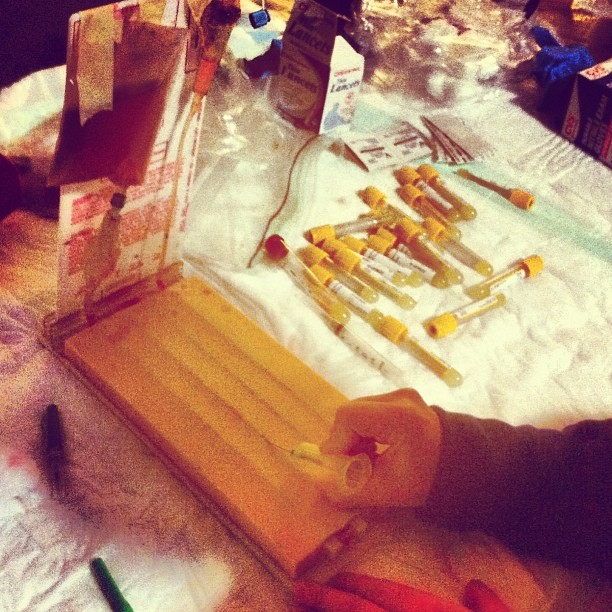I spent Saturday at my midwifery class in Amherst, MA, learning how to draw blood. I am not uncomfortable around blood, nor around bodily "things" in general. Last Monday I dissected a cat for my anatomy class here at Harvard and found that once I got over the whole dead-cat thing, it wasn't so awful (just fairly awful). Plus, I've seen a good amount of blood. Birth is messy, I've handled placentas, and I've helped with suturing tears. No big deal.
We started off with finger pricks, getting just one drop of blood, inserting it into a special slide, then popping that into a machine that reads hemoglobin levels. Hemoglobin levels reflect the blood's capacity to carry oxygen, which is of critical importance for pregnancy. Normal levels are between 12-16; less than that and a woman is at risk of, or suffers from, anemia. Women are tested early on in their pregnancy to determine their normal Hg levels, then tested again at 28 weeks. By this time, her body has created up to 50% more blood to support the growing baby and placenta. All that extra blood is also a buffer against blood loss in birth. As blood volume expands, the ratio of blood plasma to Hg shifts, so that the second test should actually reflect a relative decrease in Hg levels. That's a good sign--it means that she's made that extra blood that she needs. However, if she was borderline anemic than that expansion can tip her into anemia, and thankfully there are various dietary and supplement options available to help.
Anyways, all of my blood drained from my face just watching the finger prick test. I'm pretty sure that there's some part of our brain that lights up when we're asked to harm someone, even if it's for a good reason. Mine was really firing. I can do it, but I sure don't like it.
The second thing we did was learn how to give intramuscular injections. It's so easy, I feel like I could do it with my eyes closed. Which is, for many pointy reasons, a very, very bad idea. This skill is important for midwives who need to give an injection of a medication like pitocin (synthetic oxytocin) in the case of postpartum uterine hemorrhage. The pitocin causes the uterus to fiercely contract (which is why pitocin is used to induce or "augment" labor in hospital settings), thereby cutting off uterine blood vessels as the uterus shrinks down, stopping the bleeding. I injected an orange with so much water, it was squirting everywhere.
The third skill we learned was blood-drawing, which we would do in order to send a blood sample to a lab for a thorough work-up. They would then relay information about blood type, Rh compatibility (the + or - after the letter, ie. A+), hematocrit (the relative volume of red blood cells), platelet count, amount and type of white blood cells, information about Rubella immunity and HIV, and a long list of other kinds of data. We practiced on a rubberized board with four different depths and widths of veins running underneath. Water with red food coloring ran through the "veins," so that we were able to fill vials realistically. After practicing with the model, we practiced on each other. I don't know why I volunteered to go first--maybe I figured that I could get stuck, do my duty, and be done with it. Turns out that I'm a much bigger baby than all the real babies I'm around. But once I was able to practice on the board, I got a good sense of it. I applied the tourniquet to a student's arm, took a deep breath, said bismillah, and pretended I was sticking the model. The needle went in smoothly, I popped the vacuum sealed vial on the back of the needle, it filled up with real live person blood, I released the tourniquet and smoothly pulled the needle out, applying a cotton ball to the spot. Success! The little vial of blood meant that I had actually found a vein, which was tough for us first-timers.
Having done it now, the scariness of having blood drawn has fallen away for me. It's very simple, and would have been totally painless if I had just calmed down when having my blood drawn. Being calm and confident later on meant that I was able to act quickly, smoothly, do all the steps in order, and not cause any pain. I feel like I could handle just about anything now.




